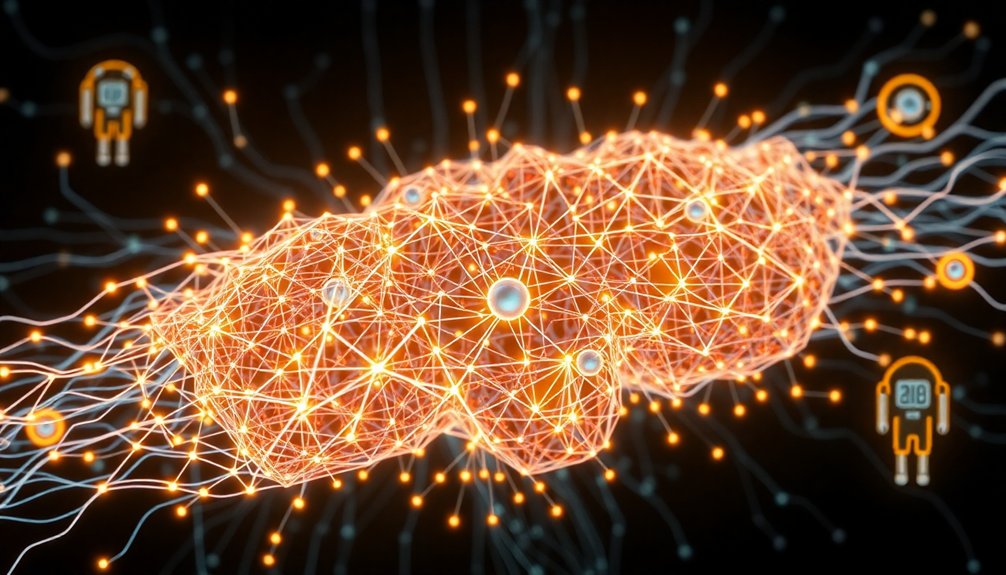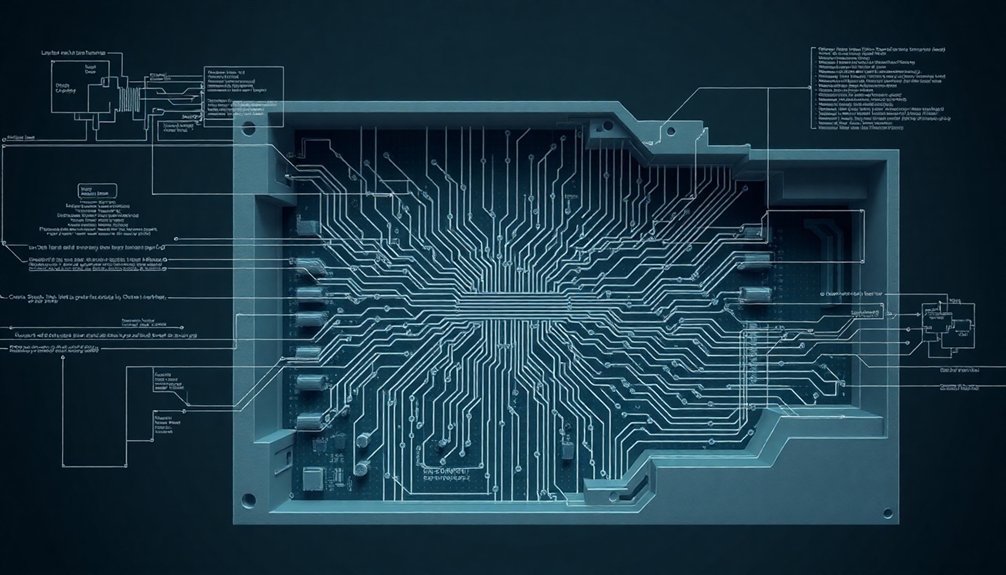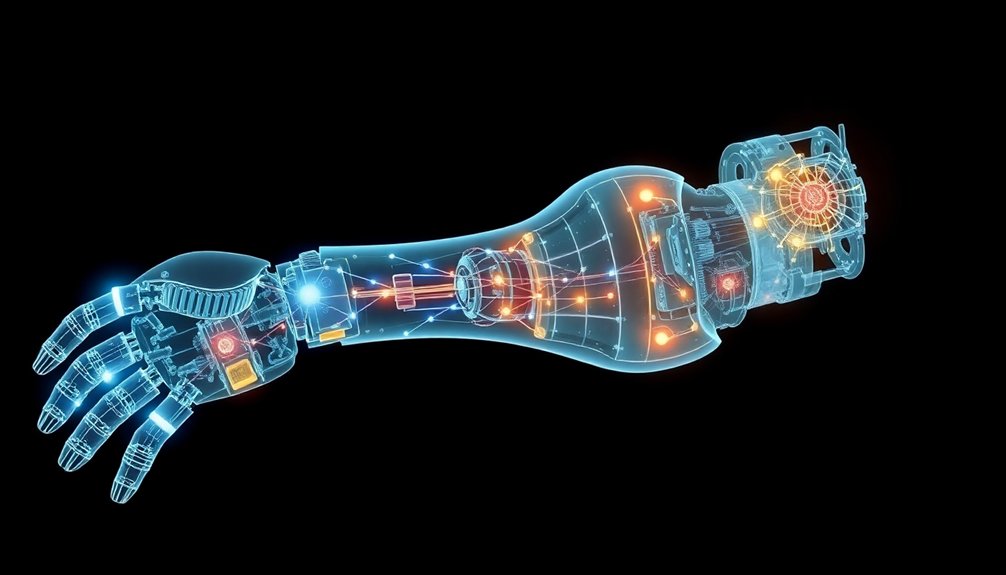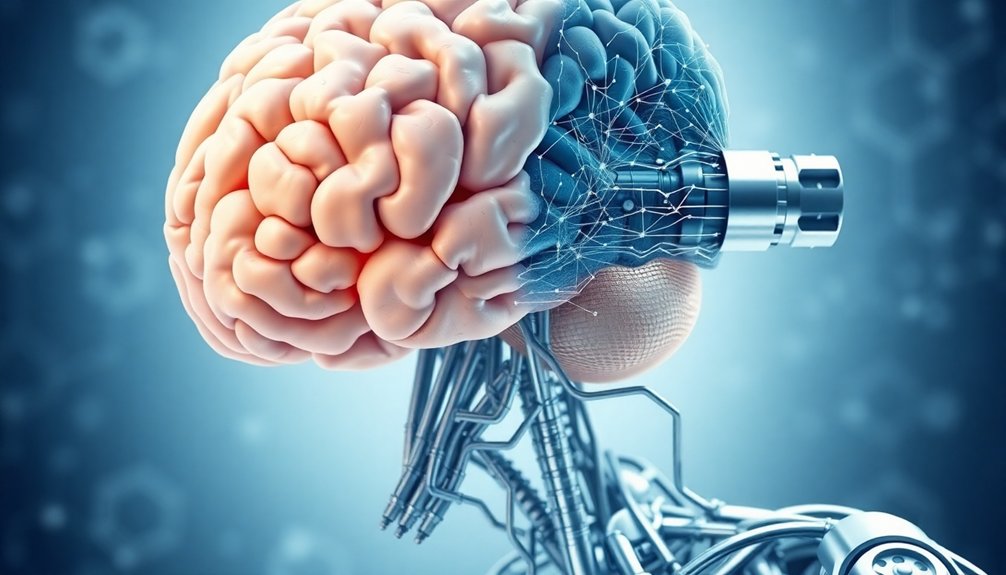Neural networks are your robot’s secret sauce—digital brains that transform metal and circuits into thinking machines. They’re like biological neurons on steroids, processing massive data in milliseconds and learning from every interaction. Think of them as your robot’s adaptable intelligence, turning pre-programmed automatons into smart companions that can recognize patterns, make decisions, and evolve. Curious about how these digital wizards actually work? Stick around, and the rabbit hole gets deeper.
Neural Networks: The Digital Brain of Modern Robotics

While robots might sound like sci-fi fantasy, neural networks are the secret sauce transforming them from clunky machines into intelligent systems that can actually think and adapt.
Think of neural networks as the artificial intelligence brain inside a robot’s metal body, mimicking how human neurons connect and learn. They’re not just fancy algorithms; they’re digital learning machines that process massive amounts of data in milliseconds.
Neural networks: the digital brain transforming robots from metal machines into intelligent, adaptive learners.
Want a robot to recognize objects or navigate complex environments? Neural networks make that happen by constantly adjusting their internal connections based on what they experience. It’s like the robot is always studying, always improving.
The coolest part? These networks don’t just follow pre-programmed instructions—they evolve, making decisions in real-time that can be surprisingly human-like. Who said robots can’t be smart?
Deep reinforcement learning enables robots to transform from mere programmed machines into adaptive learners that can navigate unpredictable environments with unprecedented flexibility.
How Artificial Neurons Mimic Biological Learning
Ever wondered how machines learn to think like humans? Neural nets are basically digital brains that gobble up information like a knowledge-hungry monster.
Here’s how artificial neurons mimic biological learning:
- Pattern Recognition: They scan massive datasets, spotting connections faster than your brain can blink.
- Weight Adjustment: Connections between neurons strengthen or weaken based on repeated exposure, just like your brain rewires itself.
- Generalization: Unlike humans, these digital learners abstract concepts without emotional baggage or personal bias.
- Continuous Evolution: Each training session transforms neural networks, turning simple algorithms into complex problem-solving machines.
Think of it like teaching a robot to learn: not by drilling facts, but by letting it experience and adapt. Humanoid robot learning demonstrates how neural networks can process sensory inputs to develop sophisticated motor skills and adaptive behaviors.
The result? An artificial brain that’s part science, part magic – constantly reshaping itself to understand our wild, weird world.
Pattern Recognition and Decision-Making in Robotic Systems

From mimicking biological learning to conquering real-world challenges, neural networks are transforming robotic systems into smart, adaptable machines that can recognize patterns and make decisions like never before. Humanoid robot technology leverages these advanced neural networks to enhance robotic performance across various industries.
Think of a neural net as a robot’s brain that learns by watching and doing. It processes sensory input faster than you can blink, turning raw data into lightning-quick decisions. Want to know how? These networks compare incoming information against learned patterns, fundamentally asking, “Have I seen something like this before?” If the answer’s yes, the robot knows exactly what to do.
Pattern recognition isn’t just about seeing; it’s about understanding context. Robots can now interpret complex environments, adapting their actions in milliseconds.
They’re learning, not just computing—and that’s pretty wild.
Training Robots: From Data Input to Intelligent Output
Because training a robot is like teaching a super-smart toddler, neural networks transform raw data into intelligent behavior through a mind-blowing process of constant learning. Humanoid robots’ advanced capabilities emerge from sophisticated neural network architectures that bridge mechanical components with intelligent processing.
Any robotics company worth its silicon knows this isn’t magic—it’s pure computational wizardry. How do they do it? Check out these neural network training secrets:
- Feed massive datasets that teach robots pattern recognition
- Use reinforcement learning to refine actions through trial and error
- Implement advanced algorithms that boost computational performance
- Enable real-time environmental adaptation for smarter decision-making
Your robot doesn’t just follow instructions; it learns, predicts, and evolves.
Think of neural networks as the brain that turns mechanical limbs into thinking machines. They’re not just programmed—they’re trained, much like how you’d teach a particularly brilliant (and potentially world-dominating) apprentice.
The future isn’t just coming; it’s learning in real-time.
Challenges and Limitations of Current Neural Network Architectures

You might think neural networks are these genius machines, but they’re more like toddlers trying to understand complex math with finger paints.
Their current architectures struggle to bridge massive gaps between computational learning and how biological brains actually process information, leaving significant blind spots in understanding true intelligence.
When you compare machine learning algorithms to the intricate, adaptable networks inside your own skull, you’ll quickly realize we’re still playing around in the kiddie pool of artificial intelligence.
Neural Net Complexity
When neural networks hit the real world, they often stumble like a toddler learning to walk. These AI brains struggle with the messy complexity of reality, desperately trying to make sense of situations that aren’t neatly labeled or predictable.
Consider the challenges:
- Limited sensory input restricts their ability to understand context
- Predefined action sets rob them of true adaptability
- Hardware constraints create rigid behavioral patterns
- Lack of common sense prevents intuitive problem-solving
Neural networks are like brilliant students who’ve memorized the textbook but freeze when faced with a pop quiz in real life. They excel in controlled environments but falter when unexpected variables emerge.
Imagine a robot trying to cook dinner – it might know recipe steps, but can it handle a suddenly dull knife or a missing ingredient? The gap between computational intelligence and practical reasoning remains frustratingly wide.
Learning Algorithm Gaps
Neural networks might look impressive on paper, but their learning algorithms are more like temperamental toddlers than genius problem-solvers. Your machine learning dreams hit roadblocks when artificial neural networks struggle to adapt beyond their training. Closed-loop control systems reveal the fundamental limitations of robotic learning architectures, demonstrating how precise but inflexible motor responses can highlight algorithmic rigidity.
They’re fundamentally rigid instruction-followers with zero common sense, trapped in a digital bubble that doesn’t translate to real-world complexity.
Imagine a robot that can calculate complex equations but can’t figure out how to pick up a coffee mug without knocking everything over. That’s the current state of neural network learning – brilliantly specialized yet frustratingly limited.
The gaps in their algorithmic understanding mean they’re more robotic script-readers than intelligent learners, unable to improvise or genuinely understand context.
Who’s really in charge here: the algorithm or the imagination?
Biological Brain Differences
While computers might dream of electric sheep, biological brains are the true masters of adaptability and learning. Your robotic friends are struggling to catch up, and here’s why:
- Sensory Complexity: Biological brains process information through rich, nuanced sensory inputs, while neural networks operate in sterile, limited environments.
- Learning Efficiency: Real-world biological brains can learn from just a few examples, whereas AI requires massive datasets.
- Contextual Understanding: Your brain naturally develops common sense and resourcefulness, skills that current robot architectures can’t replicate.
- Adaptive Flexibility: Biological systems seamlessly adjust to unpredictable scenarios, something neural networks find challenging.
Imagine trying to teach a robot to cook by only showing it YouTube videos. Spoiler alert: It won’t end well.
The intrinsic differences between biological brains and computer architectures reveal just how far we’ve got to go in AI development.
Real-World Applications of Neural Networks in Robotics

If you’ve ever wondered how robots are getting smarter than your average toaster, search no more than neural networks. These AI brains are transforming robotic systems from clunky machines to intelligent assistants that can understand, learn, and execute complex tasks. Imagine a robotic arm that doesn’t just move mechanically but comprehends context and adapts in real-time.
| Robotic Application | Neural Network Capability |
|---|---|
| Object Recognition | Visual Pattern Matching |
| Navigation | Spatial Understanding |
| Language Interaction | Natural Command Processing |
| Decision Making | Predictive Behavior Analysis |
| Industrial Tasks | Complex Action Planning |
From Levatas’ ChatGPT-powered dog to Google’s PaLM-driven industrial robots, neural networks are bridging the gap between human intention and machine execution. They’re not just following instructions—they’re interpreting, analyzing, and responding with unprecedented sophistication. Who said robots can’t be intuitive?
The Evolution of Machine Learning Algorithms
Ever since computers started learning tricks beyond simple arithmetic, machine learning algorithms have been on a wild ride of transformation. The journey’s been epic, with deep learning and large language models turning AI from a clunky experiment into a mind-bending technology.
Check out how these algorithms evolved:
- Early neural networks were basically toddlers stumbling around, barely understanding basic patterns.
- Hinton’s breakthrough revealed neurons could “wire together” when they “fire together,” making learning more organic.
- Faster computers turbocharged machine learning’s potential, enabling complex tasks like image recognition.
- Modern AI can now generate human-like text and comprehend nuanced contexts, blurring lines between machine and human intelligence.
Will robots eventually outsmart their creators? The race is on, and it’s getting seriously interesting.
Future Prospects: Bridging the Gap Between AI and Physical Intelligence

You’re standing at the frontier of a wild technological mashup where computer brains start mimicking living systems in ways that’ll make your head spin.
Neuromorphic computing is quietly revolutionizing how machines think, with biomimetic robotic systems learning to adapt and respond like biological creatures instead of rigid algorithms.
Imagine robots that can rewire their own neural pathways on the fly, learning from mistakes faster than you can say “artificial intelligence” — this isn’t science fiction, it’s the near-future landscape of adaptive machine learning that’s about to turn everything we understand about intelligence upside down.
Neuromorphic Computing Advances
While traditional computing struggles to match the brain’s incredible efficiency, neuromorphic computing is quietly revolutionizing how machines think and learn. This breakthrough technology is reshaping AI’s potential through:
- Spiking neural networks that mimic biological brain communication
- Dramatically reduced power consumption compared to conventional systems
- Enhanced real-time object recognition capabilities
- Improved robotic adaptability in complex environments
Neuromorphic computing isn’t just another tech buzzword — it’s the secret sauce transforming robots from rigid machines into intelligent, responsive systems.
Imagine robots that can learn and adapt faster than ever before, processing information more like humans and less like clunky calculators. These neural networks are basically giving machines a brain transplant, allowing them to navigate dynamic spaces with unprecedented precision.
Who wouldn’t want a robot that thinks smarter, not harder?
Biomimetic Robotic Systems
Since nature’s been engineering perfect problem-solvers for millions of years, scientists are now stealing her playbook to build smarter robots.
Biomimetic systems aren’t just copying biology—they’re revolutionizing how machines think and move. Imagine robots that can recognize and adapt like animals, using neural networks inspired by actual brain structures. The WhiskEye robot proves this isn’t sci-fi fantasy; it’s cutting-edge engineering that mimics sensory processing with jaw-dropping precision.
These brain-inspired machines are getting seriously clever. They’re learning to integrate physical actions with cognitive processing, making human-robot collaboration feel less like a clunky interaction and more like a seamless partnership.
Adaptive Machine Learning
When robots start learning like toddlers instead of clunky machines, that’s when things get really interesting. Adaptive machine learning is transforming robotic intelligence from rigid programming to flexible thinking.
Here’s how these neural networks are evolving:
- Large language models now help robots understand context beyond simple commands.
- Multimodal learning lets robots combine language, images, and actions seamlessly.
- Robots can now interpret subtle user preferences and environmental nuances.
- Example-based prompts are teaching machines to improvise like curious learners.
Imagine a robot that doesn’t just follow instructions, but actually understands them. It’s not sci-fi anymore—it’s happening right now.
People Also Ask About Robots
What Is the Concept of Neural Networks in AI?
You’ll discover neural networks are AI systems mimicking brain neurons, where interconnected nodes learn by processing data, adjusting connection weights, and recognizing complex patterns through layered computational structures that adapt and improve over time.
Does Artificial Neural Networks Mimic Human Brain?
Like a digital echo of nature’s symphony, you’ll find neural networks aren’t perfect brain mimics. They’re inspired blueprints that capture learning’s essence, but can’t fully replicate the brain’s intricate, mysterious dance of consciousness.
Are Neural Networks Based on the Brain?
You’ll find neural networks are loosely inspired by brain structures, mimicking neuronal connections and learning mechanisms. They’re not exact replicas, but computational models that draw insights from biological neural processing and adaptive behavior.
How Does the AI Brain Work?
You’ll find AI’s brain learns by adjusting neural connections, mimicking biological neurons. It processes information through interconnected layers, strengthening successful pathways while discarding ineffective ones, ultimately creating intelligent responses through complex computational learning.
Why This Matters in Robotics
You might worry neural networks are just cold, calculating machines. But they’re evolving into something more: learning systems that adapt and grow like living brains. They’ll transform robotics from rigid tools to intelligent companions. The future isn’t about machines replacing humans, but partnering with us in ways we can’t yet imagine. Neural networks are our bridge to a smarter, more collaborative technological world.
